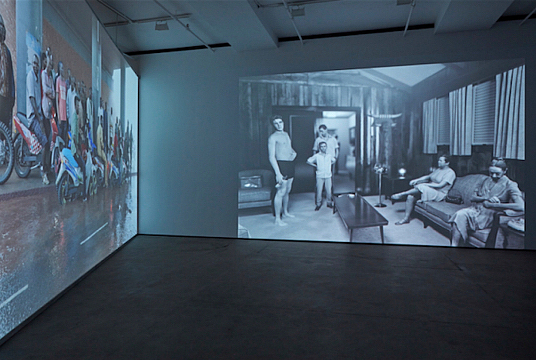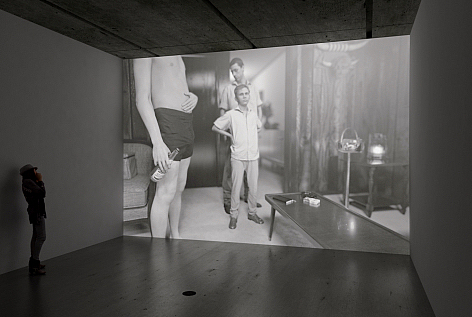Seven years ago David Claerbout (Kortrijk, 1969) exhibited at De Pont for the first time. The Shape of Time, comprising ten video installations, left an indelible mark. A magical twilight world of old black-and-white photographs, brought to life in a subtle manner, and decelerated film sequences showing a woman serving coffee on the veranda of an eighteenth-century French stately home and then waving farewell to the viewer as the sun sets. The visible passing of time evokes a sense of wonder and estrangement. With Claerbout’s new exhibition, FUTURE, the museum’s new wing will be inaugurated.
While FUTURE may seem to be a fitting title on such a festive occasion, its meaning proves to be rather ambiguous on further consideration. One of the most recent video works in the exhibition, Olympia (The real time disintegration into ruins of the Berlin Olympic stadium over the course of a thousand years), shows the deterioration of the structure in which the 1936 Olympics were held, a building fraught with historical significance. The work alludes to a bleak period, when Hitler was in power and was developing megalomaniacal architectural projects with his chief architect Albert Speer.
With the aid of digital game technology, Claerbout shows us the course of this process in ‘real time’, in any case for the next twenty-five years. Just how this art project will continue after that depends on technological developments and on whether anyone is prepared to assume responsibility for it at that point. The idea does appeal to the imagination in a powerful way: what will the stadium look like in a half-collapsed state, overgrown by weeds and bushes? The decay occurs so slowly, however, that a museum visitor cannot possibly observe this. From this point of view, even a human lifetime would be too short. So what does FUTURE actually mean?
For the first time in Europe, Claerbout is now showing his video installations in combination with the drawings that accompany and support his works’ creative process of many months, sometimes even years. Drawing enables Claerbout to get a grip on the complicated process of developing a work, which involves numerous assistants. This function of drawing is basically no different fFor rom the sketch or preparatory study that a traditional painter uses to record his ideas. Along with an understanding of modern computer technology, a command of traditional fields such as drawing, painting, sculpture and cinematography is necessary. The result being, to Claerbout’s own astonishment, a ‘conservative’ type of painterly realism. But in view of his elaborate and sometimes vehement writing that appears in the margins, the drawings are also an outlet for him. The recently published drawing catalogue elicited Claerbout’s remark that it was about time for him to reveal his methods and secret formulas.



